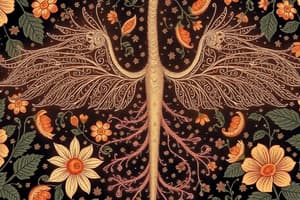Podcast
Questions and Answers
What is the primary function of ADH in the kidneys?
What is the primary function of ADH in the kidneys?
- Stimulate the secretion of aldosterone from the adrenal cortex
- Increase permeability of renal distal tubules and collecting duct to water (correct)
- Increase sodium permeability in renal distal tubules
- Decrease the reabsorption of water in the collecting duct
Which of the following factors will lead to an increased secretion of ADH?
Which of the following factors will lead to an increased secretion of ADH?
- Increased plasma osmolality and hypotension (correct)
- Low plasma osmolality and high fluid intake
- Hypervolemia and decreased blood pressure
- Alcohol consumption and increased hydration
Which condition is characterized by excessive ADH secretion?
Which condition is characterized by excessive ADH secretion?
- Hypopituitarism
- Syndrome of Inappropriate ADH Secretion (SIADH) (correct)
- Primary Hyperaldosteronism
- Diabetes Insipidus
In neurogenic diabetes insipidus, which of the following characteristics is observed?
In neurogenic diabetes insipidus, which of the following characteristics is observed?
What characterizes nephrogenic diabetes insipidus?
What characterizes nephrogenic diabetes insipidus?
Which of the following functions is primarily associated with prolactin?
Which of the following functions is primarily associated with prolactin?
What condition may arise from an excessive secretion of growth hormone in adults?
What condition may arise from an excessive secretion of growth hormone in adults?
Which hormone is primarily responsible for regulating water balance in the body?
Which hormone is primarily responsible for regulating water balance in the body?
What is the primary source for the secretion of growth hormone from the anterior pituitary?
What is the primary source for the secretion of growth hormone from the anterior pituitary?
What mechanism primarily regulates antidiuretic hormone secretion from the posterior pituitary?
What mechanism primarily regulates antidiuretic hormone secretion from the posterior pituitary?
Flashcards are hidden until you start studying
Study Notes
Mechanism of ADH Action
- ADH increases water permeability in renal distal tubules and collecting ducts.
- Binds to V2 receptors (GPCR) stimulating cAMP second messenger system.
- Water channels activated:
- Aquaporin-2 (AQP-2) incorporates into luminal membranes.
- Aquaporin-3 and AQP-4 located in basolateral membranes.
Regulation of ADH Secretion
- Regulated by osmoreceptors in the anterior hypothalamus.
- Increased secretion caused by:
- High plasma osmolality.
- Hypovolemia and hypotension (detected by receptors in carotid sinus, aortic arch, atria).
- Certain drugs (morphine, nicotine, barbiturates).
- Decreased secretion influenced by:
- Hypervolemia.
- Hypertension.
- Alcohol consumption.
Abnormalities of ADH Secretion
-
Syndrome of Inappropriate ADH Secretion (SIADH):
- Excessive ADH leading to water retention, edema, elevated blood pressure, and decreased plasma osmolarity.
- Causes include CNS disorders (head trauma, tumors) and pulmonary diseases (TB, pneumonia).
- Urine characteristics: decreased volume but increased osmolarity.
-
Diabetes Insipidus (DI):
- Deficiency of ADH due to neurogenic or nephrogenic origins.
- Features: hypovolemia, increased plasma osmolality, excessive urine output (up to 23 L/day), and decreased urine osmolarity.
Neurogenic vs Nephrogenic Diabetes Insipidus
- Both conditions impede urine concentration.
- Neurogenic DI results in decreased ADH secretion.
- Nephrogenic DI presents normal to increased ADH levels but kidneys don’t respond adequately.
Hypopituitarism
- Partial or complete deficiency of pituitary hormones due to pituitary or hypothalamic pathology.
- Affects the hypothalamic control over pituitary function.
Pituitary Gland Overview
- Located at the base of the brain in the sella turcica of the sphenoid bone.
- Connected to the hypothalamus via the pituitary stalk.
- Known as “The Master Gland” due to its role in regulating other endocrine glands.
Lobes of the Pituitary
-
Posterior Pituitary (Neurohypophysis):
- Derived from the third ventricle; connected to hypothalamus via neural pathways.
-
Anterior Pituitary (Adenohypophysis):
- Derived from Rathke’s pouch; connects to hypothalamus via vascular pathways.
Hormones Secreted by the Pituitary
-
Posterior Pituitary:
- Oxytocin and ADH (antidiuretic hormone).
-
Anterior Pituitary:
- Basophils secrete TSH, ACTH, FSH, and LH.
- Acidophils secrete GH and prolactin (PRL).
Cell Types of Anterior Pituitary
- Somatotropes: Produce human growth hormone (hGH), constituting about 50% of anterior pituitary cells.
- Corticotropes: Secrete adrenocorticotropin (ACTH).
- Thyrotropes: Produce thyroid-stimulating hormone (TSH).
- Lactotropes: Secrete prolactin (PRL).
- Gonadotropes: Secrete LH and FSH.
Role of the Hypothalamus
- Integrates endocrine and nervous system activities.
- Secretes releasing and inhibitory hormones regulating anterior pituitary secretion.
- Receives various nervous system signals to control endocrine functions.
Hypothalamic Hormone Effects on Anterior Pituitary
- TRH (Thyrotropin-releasing hormone): Stimulates release of TSH.
- GnRH (Gonadotropin-releasing hormone): Promotes release of LH and FSH.
- GHRH (Growth hormone-releasing hormone): Stimulates GH release.
- CRH (Corticotropin-releasing hormone): Promotes ACTH release.
- GHIH (Growth hormone inhibitory hormone): Inhibits GH release.
- Dopamine: Inhibits prolactin secretion.
Functions of Growth Hormone (GH)
- Promotes growth by increasing cell size and number.
- Increases protein synthesis leading to positive nitrogen balance.
- Enhances energy utilization by promoting:
- Lipolysis (fat mobilization).
- An increase in blood glucose levels, resulting in increased insulin secretion and insulin resistance.
- Reduction of glucose uptake in muscle and fat, with enhanced glucose production by the liver.
Studying That Suits You
Use AI to generate personalized quizzes and flashcards to suit your learning preferences.


